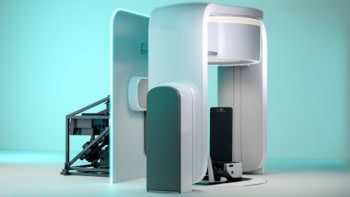A group of scientists in Israel has discovered that human sweat glands act like tiny antennas, and could in principle be used to remotely monitor a person’s emotions. This is because the emission of the glands, which lies in the sub-terahertz range, varies according to sweat levels.
Humans have several million sweat glands, which lie in the middle layer of the skin called the dermis. When the glands produce sweat, it is transported roughly 100 µm to the surface, called the epidermis, through a duct.
Researchers had assumed that these ducts are basically straight, but recent images taken using 3D optical coherence tomography showed that they are in fact helical. Because the sweat ducts were already known to be conductive, and because the dielectric permittivity of the dermis is higher than that of the epidermis, Yuri Feldman, Aharon Agranat and colleagues at the Department of Applied Physics at the Hebrew University of Jerusalem speculated that the ducts might function as helical antennas that emit over a broad range of frequencies.
Given the length of the ducts, which would have to be just a fraction of a millimetre, the structure would have a resonant frequency of around 100 GHz, in other words the low terahertz region. Unfortunately, ions in the ducts would move far too slowly to create current alternating at this speed. Feldman and colleagues therefore proposed that the high-speed movement of charge could be provided by a common biological process known as “proton hopping”, in which protons jump from one water molecule to the next.
Tried and tested
Now, The Israel researchers have tested this hypothesis. They bounced sub-terahertz radiation between 75 and 110 GHz off the hands of various people and measured the strength of the reflected radiation as a function of frequency. They did this when the people were fully relaxed and then following 20 minutes of intense jogging, taking successive measurements as the subjects returned to a relaxed state. They found that the spectra of reflection intensity were curves centred on a dip at about 90 GHz, and that the dip became less pronounced as people relaxed (Phys. Rev. Lett. 100 128102).
These results supported their theory, since emission by the sweat ducts would weaken reflection at terahertz frequencies. The fact that this weakening was most pronounced when people were sweating the most suggested that the strength of the ducts’ emission depended on sweat levels.
To see if this was true, the researchers carried out computer simulations in which terahertz beams were sent through an idealized section of a person’s skin containing eight helical sweat ducts. Because the dip became more pronounced as they increased the conductivity parameter — that is, as they increased sweat levels — the researchers concluded that sweating increases terahertz emissions. In fact, the terahertz emissions correlated well with pulse rate and blood pressure measurements too.
Signs of emotion
Feldman proposes that, in principle, simultaneous measurements of a person’s reflectance spectra at different parts of the body could provide information about their emotional state. There are number of areas of the body that have high concentrations of sweat glands, such as the forehead, the palms of the hand and the soles of the feet. The relative change in sweatiness between these different areas varies according to what caused the body to sweat — whether, for example, it was due to heat, excitement or spicy food.
“What we have shown is just the beginning,” says Feldman and Agranat. “We are very sure that the experiments validate our antenna hypothesis.”



